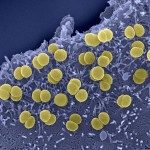Lien vers Pubmed [PMID] – 27090179
Lien DOI – 10.1128/AAC.00378-16
Antimicrob Agents Chemother 2016 07; 60(7): 4023-7
Antibiotic susceptibility testing (AST) in Neisseria meningitidis is an important part of the management of invasive meningococcal disease. It defines MICs of antibiotics that are used in treatment and/or prophylaxis and that mainly belong to the beta-lactams. The interpretation of the AST results requires breakpoints to classify the isolates into susceptible, intermediate, or resistant. The resistance to penicillin G is defined by a MIC of >0.25 mg/liter, and that of amoxicillin is defined by a MIC of >1 mg/liter. We provide data that may support revision of resistance breakpoints for beta-lactams in meningococci. We used experimental intraperitoneal infection in 8-week-old transgenic female mice expressing human transferrin and human factor H. Dynamic bioluminescence imaging was performed to follow the infection by bioluminescent meningococcus strains with different MICs. Three hours later, infected mice were treated intramuscularly using several doses of amoxicillin or penicillin G. Signal decreased during infection with a meningococcus strain showing a penicillin G MIC of 0.064 mg/liter at all doses. Signals decreased for the strain with a penicillin G MIC of 0.5 mg/liter only after treatment with the highest doses, corresponding to 250,000 units/kg of penicillin G or 200 mg/kg of amoxicillin, although this decrease was at a lower rate than that of the strain with a MIC of 0.064 mg/liter. The decrease in bioluminescent signals was associated with a decrease in the levels of the proinflammatory cytokine interleukin-6 (IL-6). Our data suggest that a high dose of amoxicillin or penicillin G can reduce growth during infection by isolates showing penicillin G MICs of >0.25 mg/liter and ≤1 mg/liter.

